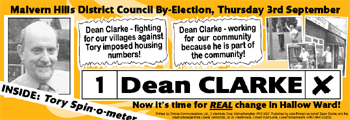There were four principal council by-elections held on 3rd September. Labour held one seat and lost one to the Tories. The Tories lost a seat to an Independent and one to the Liberal Democrats. In the six Parish and Town council elections reported to ALDC the Lib Dems held one seat and gained two seats from the Tories. The Tories held two seats and Independents one.

In the Hallow Ward of Malvern Hills council we scored a spectacular gain from the Tories in the key West Worcestershire parliamentary seat. Crucial was the Regional Spatial Strategy advocating 3500 extra houses for the village. The Tories claimed they’d been instrumental in delaying the implementation of the RSS (incidentally following the national Tory strategy revealed last week http://tinyurl.com/torydelaytactics). We pointed out that the Tories had forced through the proposal. Strong issues well used.
In the Luton and Wayfield Ward of Medway Unitary Authority in Kent we had not stood a candidate for years. The parliamentary seat is held by Labour but is a top Tory target. The remaining Labour councillors in the Ward (once Labour’s safest in the parliamentary seat) resigned and joined the independents over the Labour candidates selection. The Tory candidate was a Ghurka but the Tories were closing a local primary school.!! Clearly there was plenty of ammunition but in such a highly charged political atmosphere three leaflets and some target mail is not normally a winning campaign, and so it proved this time.
In the Southwick Ward of the newly unitary Wiltshire an Independent took the seat, leapfrogging our campaign. Whilst the Tory vote was hardest hit it does highlight the issue of how to deal with independents in the current “anti politics” environment. One thing to be extremely careful of is historic canvas data whether it’s from actual canvassing in previous elections or “how did you vote last time/usually” type questions. This data is often gathered without reference to the possible choice of candidates in the current election. Once electors are aware they have a choice beyond the main parties they can be tempted to leave their usual allegiances or abstain. It is something the party needs to address before next May. One approach may be to re-canvas the historic element of the shuttleworth in the last few days of the campaign, perhaps on the final Sunday.
Regular readers of this column may be aware that we have made significant progress in local by-elections this year with over 10 net gains in the year to date. While the causes of success in any election are notoriously difficult to unravel it is evident that one of the keys to Liberal Democrat success is that in by elections we can focus the resources from across a borough or county to campaign in the by-election ward. As Chris Huhne outlined in his article in Lib Dem news last week, our opinion poll ratings double when were not squeezed by Labour and the Tories. It is the volume and quality of our campaigning that helps us bridge this credibility gap. In 2010 the likelihood of combined local and parliamentary elections presents huge capacity challenges to the party as a whole. There are no guarantees of success but it will be clear that where we have not built sufficient financial and human resources will not win. Now is the time to join the Big Build campaign to build the capacity we need for success in 2010.